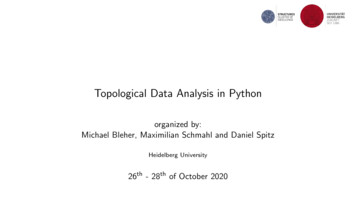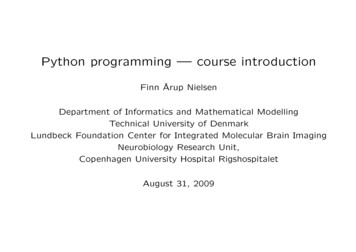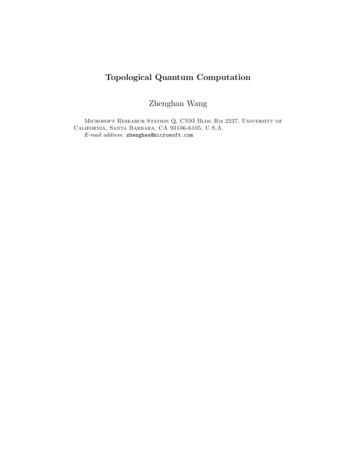
Transcription
Topological Data Analysis in Pythonorganized by:Michael Bleher, Maximilian Schmahl and Daniel SpitzHeidelberg University26th - 28th of October 2020
ContentsHomology of SpacesHomology of DataRipserApplications
ContentsHomology of SpacesHomology of DataRipserApplicationsMaximilian SchmahlPython Course on Topological Methods in Data Analysis - Day 23/ 36
HomologyAlgebraic Topology: Distinguishing topological spaces via algebraic invariantsMaximilian SchmahlPython Course on Topological Methods in Data Analysis - Day 24/ 36
HomologyAlgebraic Topology: Distinguishing topological spaces via algebraic invariantsHomology: For each dimension d0 assigns to a topological space a vector spaceX 7! Hd (X )and to a continuous map a linear map(f : X ! Y ) 7! (Hd (f ) : Hd (X ) ! Hd (Y ))Maximilian SchmahlPython Course on Topological Methods in Data Analysis - Day 24/ 36
HomologyAlgebraic Topology: Distinguishing topological spaces via algebraic invariantsHomology: For each dimension d0 assigns to a topological space a vector spaceX 7! Hd (X )and to a continuous map a linear map(f : X ! Y ) 7! (Hd (f ) : Hd (X ) ! Hd (Y ))Definitiond (X ) dim Hd (X ) is called the d-th Betti number of X .Maximilian SchmahlPython Course on Topological Methods in Data Analysis - Day 24/ 36
What homology can distinguish I000Mel XMaximilian SchmahlwYBelatßal 4Python Course on Topological Methods in Data Analysis - Day 25/ 36
What homology can distinguish IIß0Maximilian Schmahlß1ß2Python Course on Topological Methods in Data Analysis - Day 26/ 36
What homology can distinguish III0ß1Maximilian SchmahlßDf0ßPython Course on Topological Methods in Data Analysis - Day 217/ 36
What homology cannot distinguish I00SOOMaximilian SchmahlPython Course on Topological Methods in Data Analysis - Day 28/ 36
What homology cannot distinguish IIgoMaximilian SchmahlPython Course on Topological Methods in Data Analysis - Day 29/ 36
Homology in a nutshelld (X )is the number of d-dimensional holes in X .Maximilian SchmahlPython Course on Topological Methods in Data Analysis - Day 210/ 36
Geometric Simplicial Complexes IDefinitionA geometric n-simplex is the convex hull of n 1 affinely independent points in Rm .WMaximilian SchmahlPython Course on Topological Methods in Data Analysis - Day 211/ 36
Geometric Simplicial Complexes IDefinitionA geometric n-simplex is the convex hull of n 1 affinely independent points in Rm .If conv X is a simplex and Y X , then conv Y is called a face of conv X .IIIMaximilian SchmahlPython Course on Topological Methods in Data Analysis - Day 211/ 36
Geometric Simplicial Complexes IDefinitionA geometric n-simplex is the convex hull of n 1 affinely independent points in Rm .If conv X is a simplex and Y X , then conv Y is called a face of conv X .A geometric simplicial complex is a finite set K of simplices such thatI if 2 K and is a face of K , then 2 K , andI if , 2 K and \ 6 ;, then \ is a face of and of .AMaximilian SchmahlI ÄPython Course on Topological Methods in Data Analysis - Day 211/ 36
Boundary matrixDefinitionLet K { 1 , . . . ,D (di,j ) asdi,j Maximilian Schmahlm}(10be a simplicial complex. We define its boundary matrixif i is a boundary ofotherwise.jwith dimi dimPython Course on Topological Methods in Data Analysis - Day 2j1,12/ 36
Boundary matrix1 t 1DefinitionLet K { 1 , . . . ,D (di,j ) asdi,j m}(10Obe a simplicial complex. We define its boundary matrixif i is a boundary ofotherwise.jwith dimi dimj1,ExamplecMaximilian SchmahlPython Course on Topological Methods in Data Analysis - Day 212/ 36
Matrix reduction IDefinitionLet v (v1 , . . . , vm )T be a column vector. We definepivot v max{i 2 {1, . . . , m} vi 6 0}.Maximilian SchmahlPython Course on Topological Methods in Data Analysis - Day 213/ 36
Matrix reduction IDefinitionLet v (v1 , . . . , vm )T be a column vector. We definepivot v max{i 2 {1, . . . , m} vi 6 0}.If M is a matrix, we write mj for its j-th column and cols M for the set of all itsnon-zero columns.Maximilian SchmahlPython Course on Topological Methods in Data Analysis - Day 213/ 36
Matrix reduction IDefinitionLet v (v1 , . . . , vm )T be a column vector. We definepivot v max{i 2 {1, . . . , m} vi 6 0}.If M is a matrix, we write mj for its j-th column and cols M for the set of all itsnon-zero columns.We write pivots M {pivot mj mj 2 cols M}.Maximilian SchmahlPython Course on Topological Methods in Data Analysis - Day 213/ 36
Matrix reduction IDefinitionLet v (v1 , . . . , vm )T be a column vector. We definepivot v max{i 2 {1, . . . , m} vi 6 0}.If M is a matrix, we write mj for its j-th column and cols M for the set of all itsnon-zero columns.We write pivots M {pivot mj mj 2 cols M}.We say that M is reduced if pivot mj mk implies mj mk for all mj , mk 2 cols M.mpiu.tnMaximilian SchmahlPython Course on Topological Methods in Data Analysis - Day 213/ 36
Matrix reduction IDefinitionLet v (v1 , . . . , vm )T be a column vector. We definepivot v max{i 2 {1, . . . , m} vi 6 0}.If M is a matrix, we write mj for its j-th column and cols M for the set of all itsnon-zero columns.We write pivots M {pivot mj mj 2 cols M}.We say that M is reduced if pivot mj mk implies mj mk for all mj , mk 2 cols M.ExampleReduced:Not reduced:Maximilian SchmahlIcPython Course on Topological Methods in Data Analysis - Day 213/ 36
Matrix reduction IIDefinitionLet M be a matrix. We say that (R, V ) is a reduction of M if R is reduced, V isupper-triangular and invertible and we have R MV .Maximilian SchmahlPython Course on Topological Methods in Data Analysis - Day 214/ 36
Matrix reduction IIDefinitionLet M be a matrix. We say that (R, V ) is a reduction of M if R is reduced, V isupper-triangular and invertible and we have R MV .Input: MOutput: (R, V ) reduction of MRMVIwhile 9i j with pivot Ri pivot Rj doRjRj RiVjVj Viend whilereturn (R, V )Maximilian SchmahlPython Course on Topological Methods in Data Analysis - Day 214/ 36
Matrix reduction IIIIMaximilian SchmahlILalPython Course on Topological Methods in Data Analysis - Day 215/ 36
Computing homology ITheoremLet K { 1 , . . . , m } be a simplicial complex with boundary matrix D. Let (R, V ) bea reduction of D. Thend (K )Maximilian Schmahl #{i Ri 0, i 2/ pivots R, dimi d}.Python Course on Topological Methods in Data Analysis - Day 216/ 36
Computing homology ITheoremLet K { 1 , . . . , m } be a simplicial complex with boundary matrix D. Let (R, V ) bea reduction of D. Thend (K )ExampleO #{i Ri 0, i 2/ pivots R, dimEfdirMaximilian SchmahlO2 3ldrini d}.RtPivots RPython Course on Topological Methods in Data Analysis - Day 2L2,316/ 36
Computing homology IITopological spaceTriangulationSimplicial complexMatrix reductionBetti numbersMaximilian SchmahlPython Course on Topological Methods in Data Analysis - Day 217/ 36
ContentsHomology of SpacesHomology of DataRipserApplicationsMaximilian SchmahlPython Course on Topological Methods in Data Analysis - Day 218/ 36
Manifold recovery IMaximilian SchmahlPython Course on Topological Methods in Data Analysis - Day 219/ 36
Manifold recovery IMaximilian SchmahlPython Course on Topological Methods in Data Analysis - Day 219/ 36
Manifold recovery I0Maximilian SchmahlPython Course on Topological Methods in Data Analysis - Day 219/ 36
Manifold recovery IMaximilian SchmahlPython Course on Topological Methods in Data Analysis - Day 219/ 36
Manifold recovery IMaximilian SchmahlPython Course on Topological Methods in Data Analysis - Day 219/ 36
Manifold recovery IITheorem (Niyogi, Smale, Weinberger)Let M Rk be a manifoldS and P M. There exists c(M) 0 such that for everyc(M) 0 with M x2P B (x) we have









